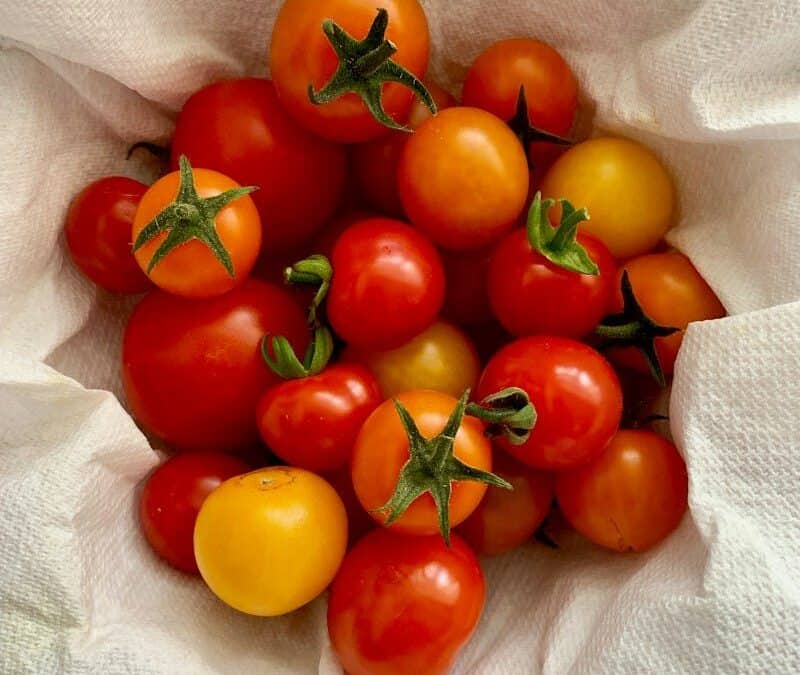Hi Reader,
I was in the backyard one morning earlier this week when I noticed several ripe cherry tomatoes. This delighted me to no end. When I lived in Connecticut I had a large garden and grew a plethora of vegetables, my favorite is tomatoes.
Since moving to California I can grow beautiful flowers, berries, and citrus but not tomatoes. I still plant them every year, hope springs eternal in this gal’s heart. This year, for reasons beyond my comprehension, I have tomatoes. YUM!
|
|
Later that evening when I was jotting my gratitude practice into my journal (the tomatoes got two spots one on the gratitude list and one on the ‘done’ list’. Such a simple pleasure. It reminded me of the power of the simple things.
In a world that often demands our attention and pulls us in multiple directions, the practice of gratitude serves as a quiet yet profound reminder to pause, reflect, and appreciate the blessings that surround us. Before you cast your gaze elsewhere with a “yeah yeah I know” take a moment and consider the pints below. Gratitude has been found to have significant physiological and psychological effects that contribute to our overall well-being.
The Science of Gratitude: Physiological Effects
Research has shown that practicing gratitude can have tangible effects on the body, mind, and spirit. When we express gratitude, our brain releases dopamine and serotonin, otherwise known as the “feel-good” neurotransmitters. These chemicals not only enhance our mood but also contribute to reducing stress and anxiety levels.
It can also trigger the release of oxytocin, often referred to as the “love hormone.” Oxytocin fosters feelings of connection and bonding, deepening our relationships and social connections. In a world where digital interactions often dominate, gratitude helps us feel closer to the people around us. It’s easy, quick, and also influences your biofield(energy). The frequency of gratitude can increase your energetic frequency, and that feels great.
Five Types of Gratitude Practices
- Gratitude Journaling: The most common type of gratitude practice. Take a few minutes each day to jot down three things you’re grateful for( bonus points for no repeats in a month). They can be as simple as a warm cup of tea, a smile from a stranger, or red tomatoes on your tomato plant 🍅. Shifting attention to the positive aspects of our lives, we train our minds to notice the good even when the going gets rough.
- Gratitude Letters: Pen a heartfelt letter to someone who has had a positive impact on your life. Sharing these letters can brighten someone’s day and deepen the sense of connection between you, but sharing is optional. A variation of this is to write to some part of yourself like that 5-year-old you who was playful and fun or the wise 80-year-old version of you.
- Mindful Moments of Gratitude: Throughout the day, pause for a moment of mindfulness, this in and of itself is a great stress reliever. Take a deep breath and consciously acknowledge something you’re grateful for in that moment. It could be the sun shining through the window or the sound of a fountain outside your window.
- Gratitude Walks: During a walk, focus your attention on the beauty around you. Take in the sights, sounds, and scents of nature. The scent of jasmine on my morning walk is amazing, taking a moment to inhale the scent always makes me feel grateful. With each step, express gratitude for the world you’re privileged to be a part of. My friend Tawnya takes it a step further and takes a quick picture and then writes a short note about what she’s grateful for later in the day.
- Gratitude Meditation: Dedicate a few minutes to meditation. With each breath, bring to mind something you’re grateful for. As you inhale, think of what you’re thankful for, and as you exhale, release any tension or stress.
Cultivating a Gratitude Mindset
Cultivating gratitude isn’t about ignoring life’s challenges or pretending that difficulties don’t exist. It’s about training ourselves to see beyond the challenges and to recognize the beauty in the small moments. By actively seeking out and acknowledging the positives, we shift our perspective and foster a mindset of abundance.
Gratitude also encourages us to be present. In a world of constant distractions, it invites us to be fully engaged in the here and now, cherishing the moments that often go unnoticed. It helps us slow down, savoring life’s experiences and finding joy in the ordinary.
I’m currently using a gratitude journal as a segway from my work day to the evening. It’s a combination of gratitude, acknowledgment for what I got done, an affirmation, and to-do list for the next day. It helps me unplug from the busyness of the day.
The Ripple Effect of Gratitude
The effects of gratitude ripple out beyond our personal well-being. As we express gratitude, we create a positive atmosphere around us.
The increase in our energetic frequency helps influence the frequency of others’ energy and the general collective energy. And we can all use a little extra boost sometimes.
What’s your favorite gratitude practice? Hit reply and let me know
Be Well,
Cathy
|
|
P.S. The gratitude journal I have been using is available here
Upcoming Workshops, Classes, Challenges
~ I’m working on some shifts in my business, looking to create more community, write more, and do more research along the way I’ll share as things become more clear.
My private coaching/healing practice is currently full

